Griffith College: Woolworths' Planning and Strategic Management Case
VerifiedAdded on 2023/04/21
|10
|2464
|206
Case Study
AI Summary
This case study analyzes the strategic and management challenges faced by Woolworths, a leading Australian retailer. It identifies key issues such as positioning, market share, and competition from rivals like Coles and ALDI. The analysis employs SWOT analysis and Porter’s five forces model to evaluate Woolworths' internal and external environments. The report discusses the positive and negative aspects of these theories in the context of Woolworths and offers recommendations for improving the company's positioning, pricing strategy, and customer engagement, emphasizing the need for innovation and efficient business practices. The study concludes that effective planning and strategy implementation are crucial for Woolworths to overcome its challenges and enhance its market position.
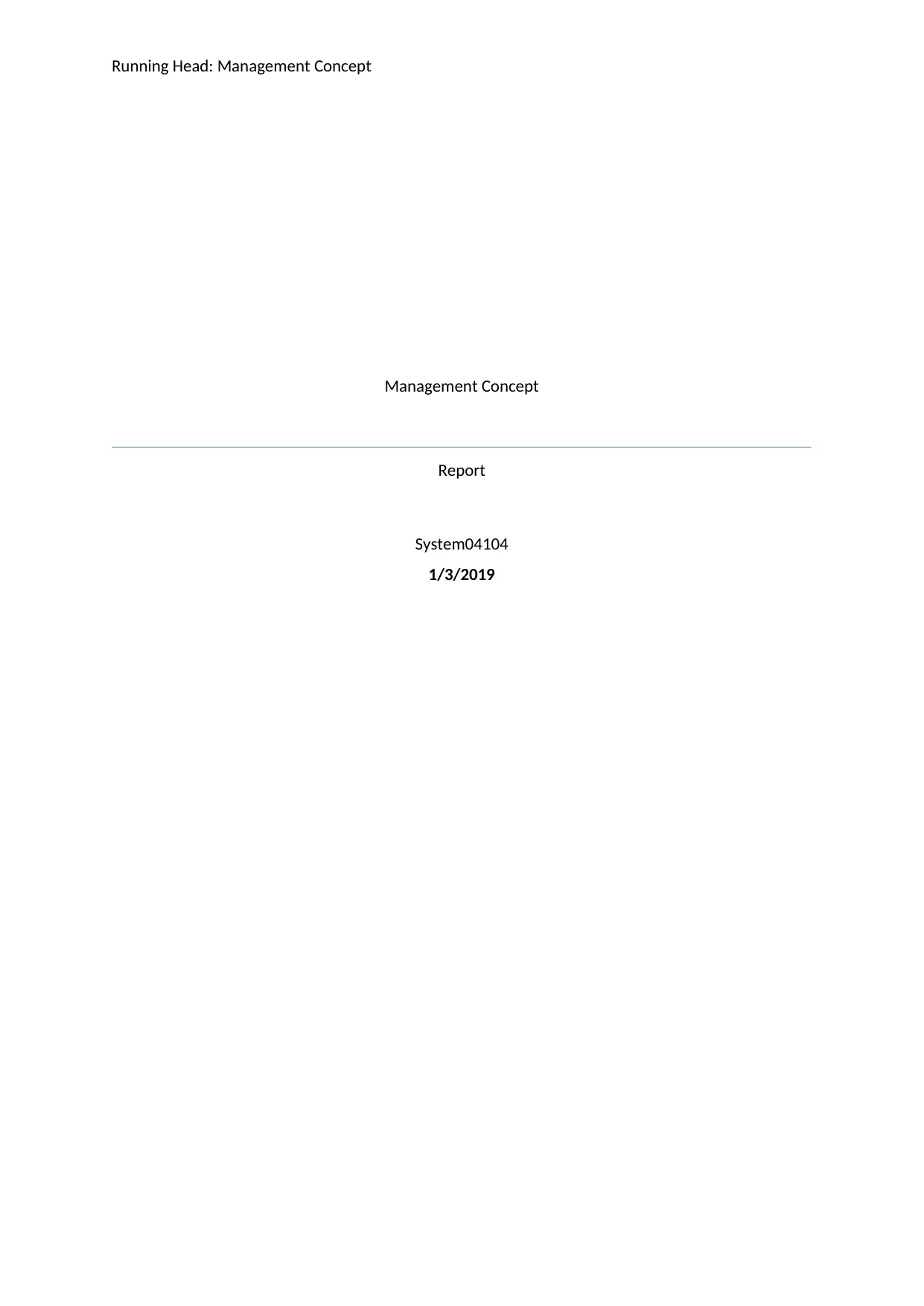
Running Head: Management Concept
Management Concept
Report
System04104
1/3/2019
Management Concept
Report
System04104
1/3/2019
Paraphrase This Document
Need a fresh take? Get an instant paraphrase of this document with our AI Paraphraser
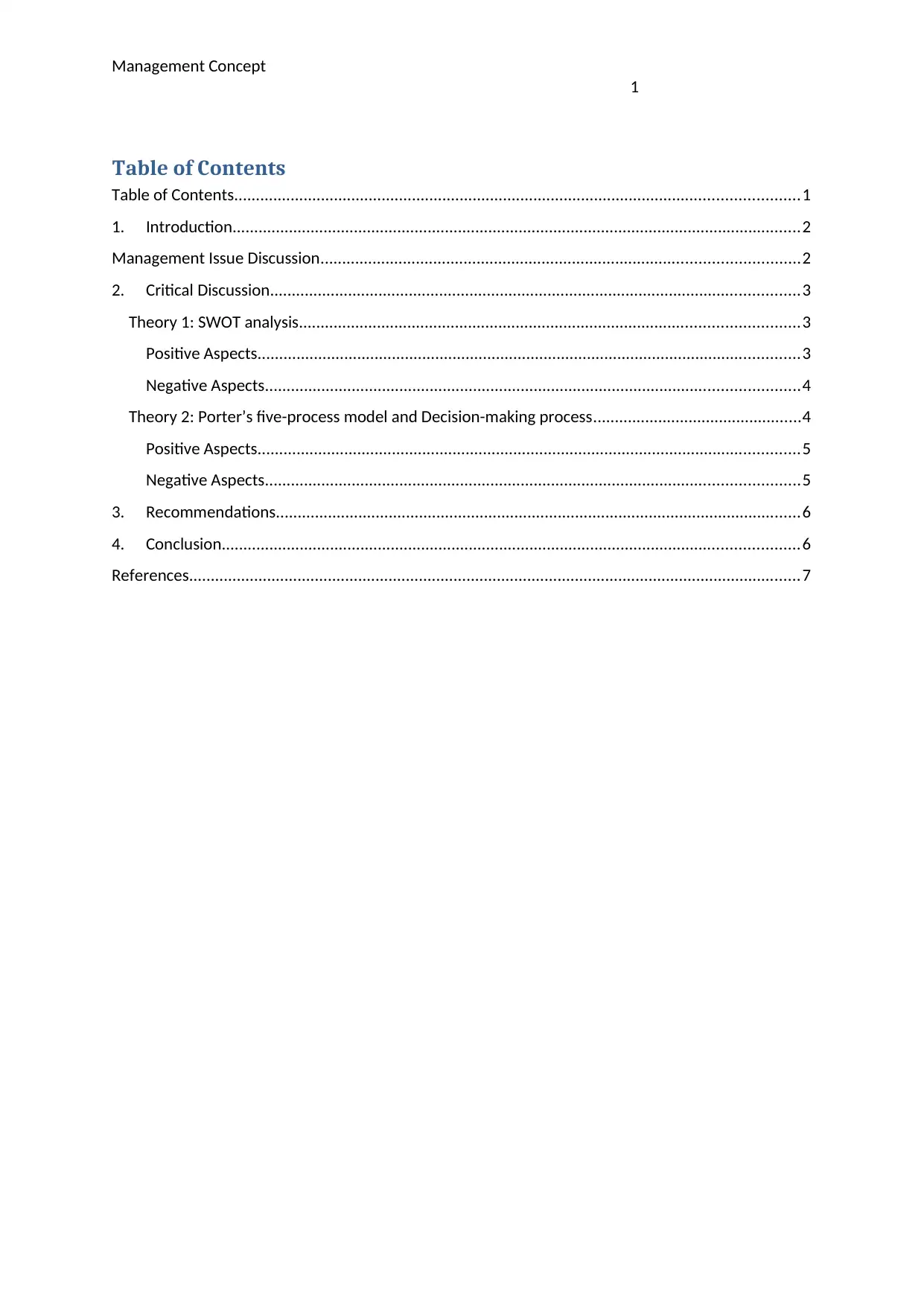
Management Concept
1
Table of Contents
Table of Contents..................................................................................................................................1
1. Introduction...................................................................................................................................2
Management Issue Discussion..............................................................................................................2
2. Critical Discussion..........................................................................................................................3
Theory 1: SWOT analysis...................................................................................................................3
Positive Aspects.............................................................................................................................3
Negative Aspects...........................................................................................................................4
Theory 2: Porter’s five-process model and Decision-making process................................................4
Positive Aspects.............................................................................................................................5
Negative Aspects...........................................................................................................................5
3. Recommendations.........................................................................................................................6
4. Conclusion.....................................................................................................................................6
References.............................................................................................................................................7
1
Table of Contents
Table of Contents..................................................................................................................................1
1. Introduction...................................................................................................................................2
Management Issue Discussion..............................................................................................................2
2. Critical Discussion..........................................................................................................................3
Theory 1: SWOT analysis...................................................................................................................3
Positive Aspects.............................................................................................................................3
Negative Aspects...........................................................................................................................4
Theory 2: Porter’s five-process model and Decision-making process................................................4
Positive Aspects.............................................................................................................................5
Negative Aspects...........................................................................................................................5
3. Recommendations.........................................................................................................................6
4. Conclusion.....................................................................................................................................6
References.............................................................................................................................................7
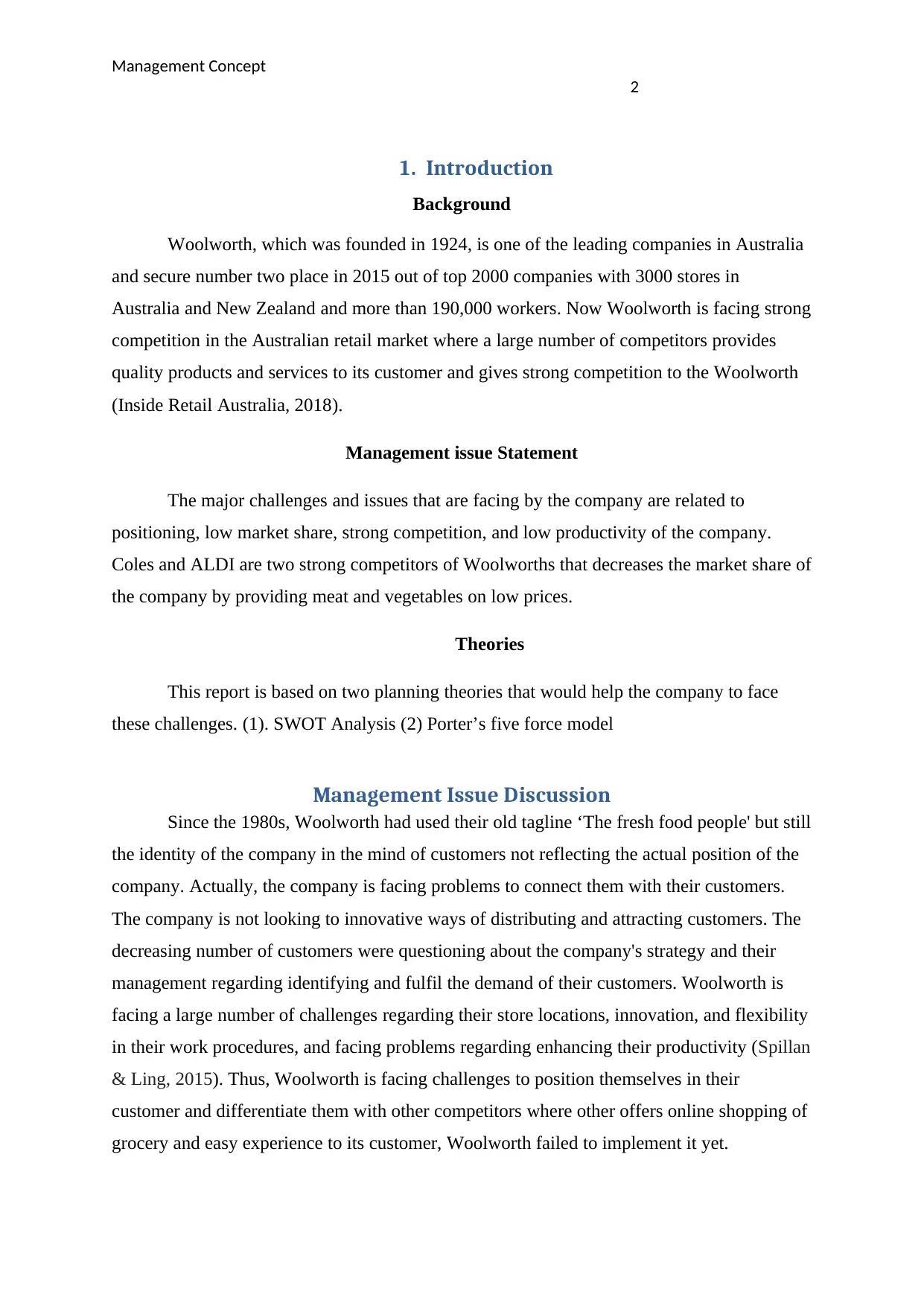
Management Concept
2
1. Introduction
Background
Woolworth, which was founded in 1924, is one of the leading companies in Australia
and secure number two place in 2015 out of top 2000 companies with 3000 stores in
Australia and New Zealand and more than 190,000 workers. Now Woolworth is facing strong
competition in the Australian retail market where a large number of competitors provides
quality products and services to its customer and gives strong competition to the Woolworth
(Inside Retail Australia, 2018).
Management issue Statement
The major challenges and issues that are facing by the company are related to
positioning, low market share, strong competition, and low productivity of the company.
Coles and ALDI are two strong competitors of Woolworths that decreases the market share of
the company by providing meat and vegetables on low prices.
Theories
This report is based on two planning theories that would help the company to face
these challenges. (1). SWOT Analysis (2) Porter’s five force model
Management Issue Discussion
Since the 1980s, Woolworth had used their old tagline ‘The fresh food people' but still
the identity of the company in the mind of customers not reflecting the actual position of the
company. Actually, the company is facing problems to connect them with their customers.
The company is not looking to innovative ways of distributing and attracting customers. The
decreasing number of customers were questioning about the company's strategy and their
management regarding identifying and fulfil the demand of their customers. Woolworth is
facing a large number of challenges regarding their store locations, innovation, and flexibility
in their work procedures, and facing problems regarding enhancing their productivity (Spillan
& Ling, 2015). Thus, Woolworth is facing challenges to position themselves in their
customer and differentiate them with other competitors where other offers online shopping of
grocery and easy experience to its customer, Woolworth failed to implement it yet.
2
1. Introduction
Background
Woolworth, which was founded in 1924, is one of the leading companies in Australia
and secure number two place in 2015 out of top 2000 companies with 3000 stores in
Australia and New Zealand and more than 190,000 workers. Now Woolworth is facing strong
competition in the Australian retail market where a large number of competitors provides
quality products and services to its customer and gives strong competition to the Woolworth
(Inside Retail Australia, 2018).
Management issue Statement
The major challenges and issues that are facing by the company are related to
positioning, low market share, strong competition, and low productivity of the company.
Coles and ALDI are two strong competitors of Woolworths that decreases the market share of
the company by providing meat and vegetables on low prices.
Theories
This report is based on two planning theories that would help the company to face
these challenges. (1). SWOT Analysis (2) Porter’s five force model
Management Issue Discussion
Since the 1980s, Woolworth had used their old tagline ‘The fresh food people' but still
the identity of the company in the mind of customers not reflecting the actual position of the
company. Actually, the company is facing problems to connect them with their customers.
The company is not looking to innovative ways of distributing and attracting customers. The
decreasing number of customers were questioning about the company's strategy and their
management regarding identifying and fulfil the demand of their customers. Woolworth is
facing a large number of challenges regarding their store locations, innovation, and flexibility
in their work procedures, and facing problems regarding enhancing their productivity (Spillan
& Ling, 2015). Thus, Woolworth is facing challenges to position themselves in their
customer and differentiate them with other competitors where other offers online shopping of
grocery and easy experience to its customer, Woolworth failed to implement it yet.
⊘ This is a preview!⊘
Do you want full access?
Subscribe today to unlock all pages.

Trusted by 1+ million students worldwide
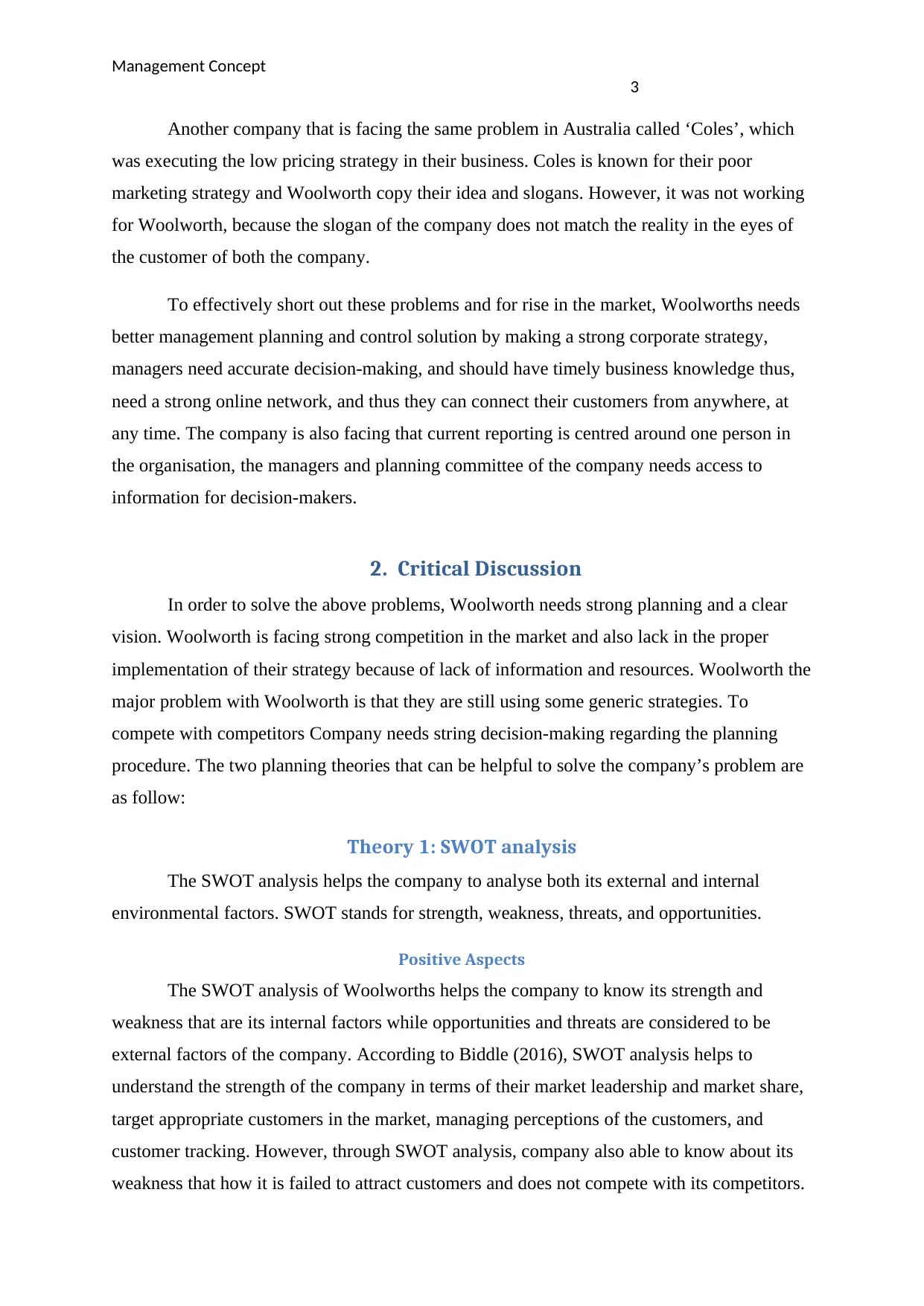
Management Concept
3
Another company that is facing the same problem in Australia called ‘Coles’, which
was executing the low pricing strategy in their business. Coles is known for their poor
marketing strategy and Woolworth copy their idea and slogans. However, it was not working
for Woolworth, because the slogan of the company does not match the reality in the eyes of
the customer of both the company.
To effectively short out these problems and for rise in the market, Woolworths needs
better management planning and control solution by making a strong corporate strategy,
managers need accurate decision-making, and should have timely business knowledge thus,
need a strong online network, and thus they can connect their customers from anywhere, at
any time. The company is also facing that current reporting is centred around one person in
the organisation, the managers and planning committee of the company needs access to
information for decision-makers.
2. Critical Discussion
In order to solve the above problems, Woolworth needs strong planning and a clear
vision. Woolworth is facing strong competition in the market and also lack in the proper
implementation of their strategy because of lack of information and resources. Woolworth the
major problem with Woolworth is that they are still using some generic strategies. To
compete with competitors Company needs string decision-making regarding the planning
procedure. The two planning theories that can be helpful to solve the company’s problem are
as follow:
Theory 1: SWOT analysis
The SWOT analysis helps the company to analyse both its external and internal
environmental factors. SWOT stands for strength, weakness, threats, and opportunities.
Positive Aspects
The SWOT analysis of Woolworths helps the company to know its strength and
weakness that are its internal factors while opportunities and threats are considered to be
external factors of the company. According to Biddle (2016), SWOT analysis helps to
understand the strength of the company in terms of their market leadership and market share,
target appropriate customers in the market, managing perceptions of the customers, and
customer tracking. However, through SWOT analysis, company also able to know about its
weakness that how it is failed to attract customers and does not compete with its competitors.
3
Another company that is facing the same problem in Australia called ‘Coles’, which
was executing the low pricing strategy in their business. Coles is known for their poor
marketing strategy and Woolworth copy their idea and slogans. However, it was not working
for Woolworth, because the slogan of the company does not match the reality in the eyes of
the customer of both the company.
To effectively short out these problems and for rise in the market, Woolworths needs
better management planning and control solution by making a strong corporate strategy,
managers need accurate decision-making, and should have timely business knowledge thus,
need a strong online network, and thus they can connect their customers from anywhere, at
any time. The company is also facing that current reporting is centred around one person in
the organisation, the managers and planning committee of the company needs access to
information for decision-makers.
2. Critical Discussion
In order to solve the above problems, Woolworth needs strong planning and a clear
vision. Woolworth is facing strong competition in the market and also lack in the proper
implementation of their strategy because of lack of information and resources. Woolworth the
major problem with Woolworth is that they are still using some generic strategies. To
compete with competitors Company needs string decision-making regarding the planning
procedure. The two planning theories that can be helpful to solve the company’s problem are
as follow:
Theory 1: SWOT analysis
The SWOT analysis helps the company to analyse both its external and internal
environmental factors. SWOT stands for strength, weakness, threats, and opportunities.
Positive Aspects
The SWOT analysis of Woolworths helps the company to know its strength and
weakness that are its internal factors while opportunities and threats are considered to be
external factors of the company. According to Biddle (2016), SWOT analysis helps to
understand the strength of the company in terms of their market leadership and market share,
target appropriate customers in the market, managing perceptions of the customers, and
customer tracking. However, through SWOT analysis, company also able to know about its
weakness that how it is failed to attract customers and does not compete with its competitors.
Paraphrase This Document
Need a fresh take? Get an instant paraphrase of this document with our AI Paraphraser
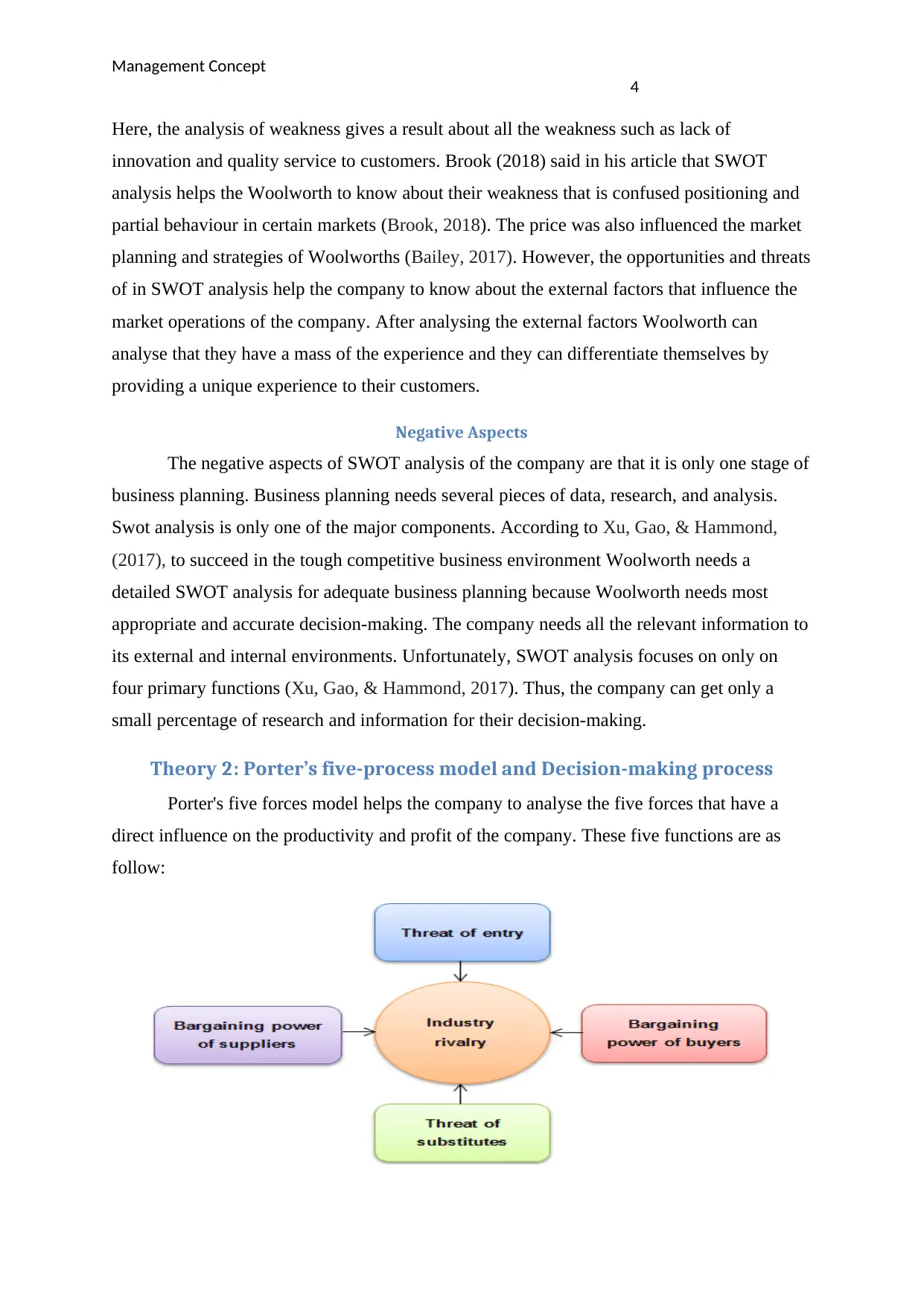
Management Concept
4
Here, the analysis of weakness gives a result about all the weakness such as lack of
innovation and quality service to customers. Brook (2018) said in his article that SWOT
analysis helps the Woolworth to know about their weakness that is confused positioning and
partial behaviour in certain markets (Brook, 2018). The price was also influenced the market
planning and strategies of Woolworths (Bailey, 2017). However, the opportunities and threats
of in SWOT analysis help the company to know about the external factors that influence the
market operations of the company. After analysing the external factors Woolworth can
analyse that they have a mass of the experience and they can differentiate themselves by
providing a unique experience to their customers.
Negative Aspects
The negative aspects of SWOT analysis of the company are that it is only one stage of
business planning. Business planning needs several pieces of data, research, and analysis.
Swot analysis is only one of the major components. According to Xu, Gao, & Hammond,
(2017), to succeed in the tough competitive business environment Woolworth needs a
detailed SWOT analysis for adequate business planning because Woolworth needs most
appropriate and accurate decision-making. The company needs all the relevant information to
its external and internal environments. Unfortunately, SWOT analysis focuses on only on
four primary functions (Xu, Gao, & Hammond, 2017). Thus, the company can get only a
small percentage of research and information for their decision-making.
Theory 2: Porter’s five-process model and Decision-making process
Porter's five forces model helps the company to analyse the five forces that have a
direct influence on the productivity and profit of the company. These five functions are as
follow:
4
Here, the analysis of weakness gives a result about all the weakness such as lack of
innovation and quality service to customers. Brook (2018) said in his article that SWOT
analysis helps the Woolworth to know about their weakness that is confused positioning and
partial behaviour in certain markets (Brook, 2018). The price was also influenced the market
planning and strategies of Woolworths (Bailey, 2017). However, the opportunities and threats
of in SWOT analysis help the company to know about the external factors that influence the
market operations of the company. After analysing the external factors Woolworth can
analyse that they have a mass of the experience and they can differentiate themselves by
providing a unique experience to their customers.
Negative Aspects
The negative aspects of SWOT analysis of the company are that it is only one stage of
business planning. Business planning needs several pieces of data, research, and analysis.
Swot analysis is only one of the major components. According to Xu, Gao, & Hammond,
(2017), to succeed in the tough competitive business environment Woolworth needs a
detailed SWOT analysis for adequate business planning because Woolworth needs most
appropriate and accurate decision-making. The company needs all the relevant information to
its external and internal environments. Unfortunately, SWOT analysis focuses on only on
four primary functions (Xu, Gao, & Hammond, 2017). Thus, the company can get only a
small percentage of research and information for their decision-making.
Theory 2: Porter’s five-process model and Decision-making process
Porter's five forces model helps the company to analyse the five forces that have a
direct influence on the productivity and profit of the company. These five functions are as
follow:
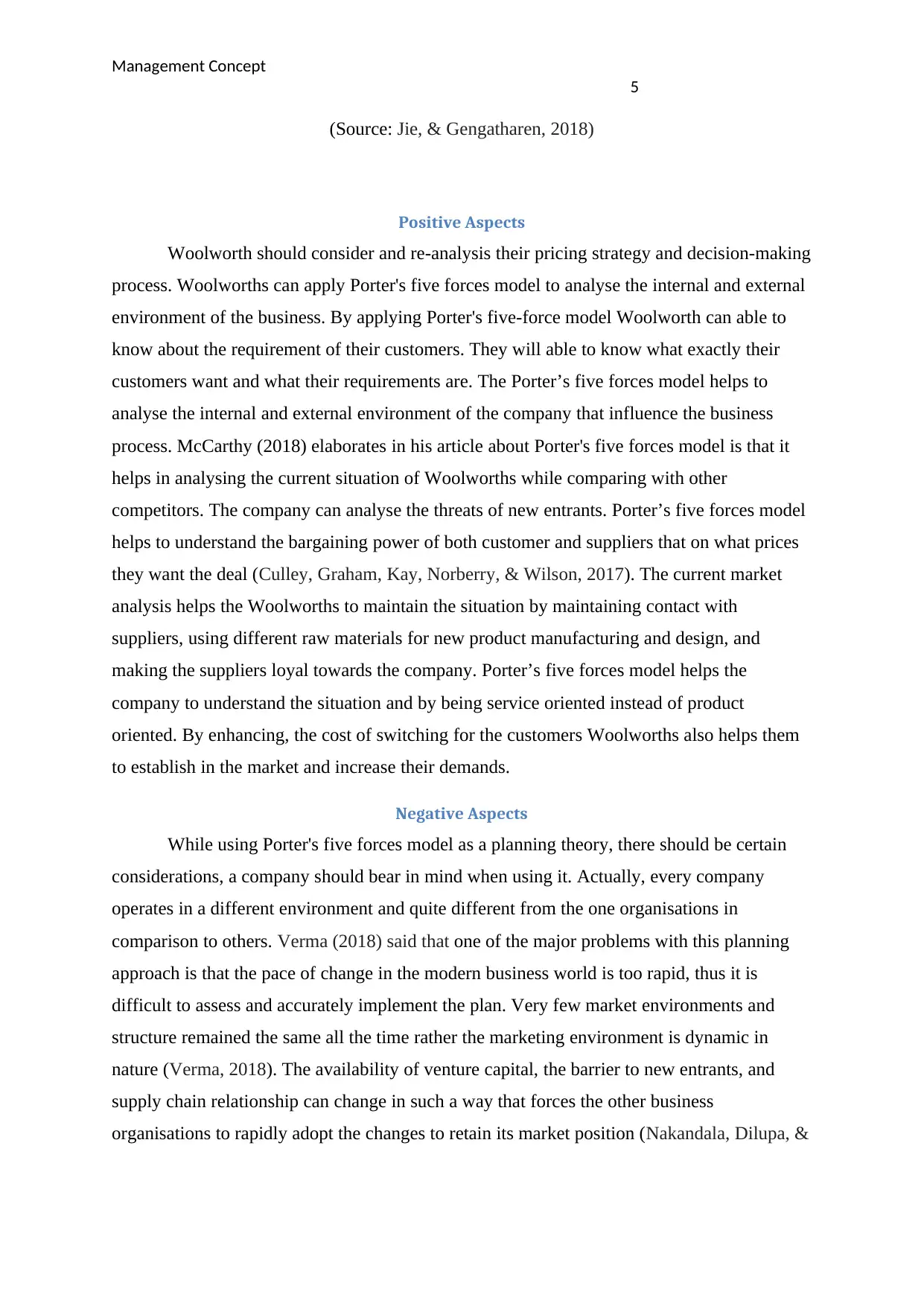
Management Concept
5
(Source: Jie, & Gengatharen, 2018)
Positive Aspects
Woolworth should consider and re-analysis their pricing strategy and decision-making
process. Woolworths can apply Porter's five forces model to analyse the internal and external
environment of the business. By applying Porter's five-force model Woolworth can able to
know about the requirement of their customers. They will able to know what exactly their
customers want and what their requirements are. The Porter’s five forces model helps to
analyse the internal and external environment of the company that influence the business
process. McCarthy (2018) elaborates in his article about Porter's five forces model is that it
helps in analysing the current situation of Woolworths while comparing with other
competitors. The company can analyse the threats of new entrants. Porter’s five forces model
helps to understand the bargaining power of both customer and suppliers that on what prices
they want the deal (Culley, Graham, Kay, Norberry, & Wilson, 2017). The current market
analysis helps the Woolworths to maintain the situation by maintaining contact with
suppliers, using different raw materials for new product manufacturing and design, and
making the suppliers loyal towards the company. Porter’s five forces model helps the
company to understand the situation and by being service oriented instead of product
oriented. By enhancing, the cost of switching for the customers Woolworths also helps them
to establish in the market and increase their demands.
Negative Aspects
While using Porter's five forces model as a planning theory, there should be certain
considerations, a company should bear in mind when using it. Actually, every company
operates in a different environment and quite different from the one organisations in
comparison to others. Verma (2018) said that one of the major problems with this planning
approach is that the pace of change in the modern business world is too rapid, thus it is
difficult to assess and accurately implement the plan. Very few market environments and
structure remained the same all the time rather the marketing environment is dynamic in
nature (Verma, 2018). The availability of venture capital, the barrier to new entrants, and
supply chain relationship can change in such a way that forces the other business
organisations to rapidly adopt the changes to retain its market position (Nakandala, Dilupa, &
5
(Source: Jie, & Gengatharen, 2018)
Positive Aspects
Woolworth should consider and re-analysis their pricing strategy and decision-making
process. Woolworths can apply Porter's five forces model to analyse the internal and external
environment of the business. By applying Porter's five-force model Woolworth can able to
know about the requirement of their customers. They will able to know what exactly their
customers want and what their requirements are. The Porter’s five forces model helps to
analyse the internal and external environment of the company that influence the business
process. McCarthy (2018) elaborates in his article about Porter's five forces model is that it
helps in analysing the current situation of Woolworths while comparing with other
competitors. The company can analyse the threats of new entrants. Porter’s five forces model
helps to understand the bargaining power of both customer and suppliers that on what prices
they want the deal (Culley, Graham, Kay, Norberry, & Wilson, 2017). The current market
analysis helps the Woolworths to maintain the situation by maintaining contact with
suppliers, using different raw materials for new product manufacturing and design, and
making the suppliers loyal towards the company. Porter’s five forces model helps the
company to understand the situation and by being service oriented instead of product
oriented. By enhancing, the cost of switching for the customers Woolworths also helps them
to establish in the market and increase their demands.
Negative Aspects
While using Porter's five forces model as a planning theory, there should be certain
considerations, a company should bear in mind when using it. Actually, every company
operates in a different environment and quite different from the one organisations in
comparison to others. Verma (2018) said that one of the major problems with this planning
approach is that the pace of change in the modern business world is too rapid, thus it is
difficult to assess and accurately implement the plan. Very few market environments and
structure remained the same all the time rather the marketing environment is dynamic in
nature (Verma, 2018). The availability of venture capital, the barrier to new entrants, and
supply chain relationship can change in such a way that forces the other business
organisations to rapidly adopt the changes to retain its market position (Nakandala, Dilupa, &
⊘ This is a preview!⊘
Do you want full access?
Subscribe today to unlock all pages.

Trusted by 1+ million students worldwide
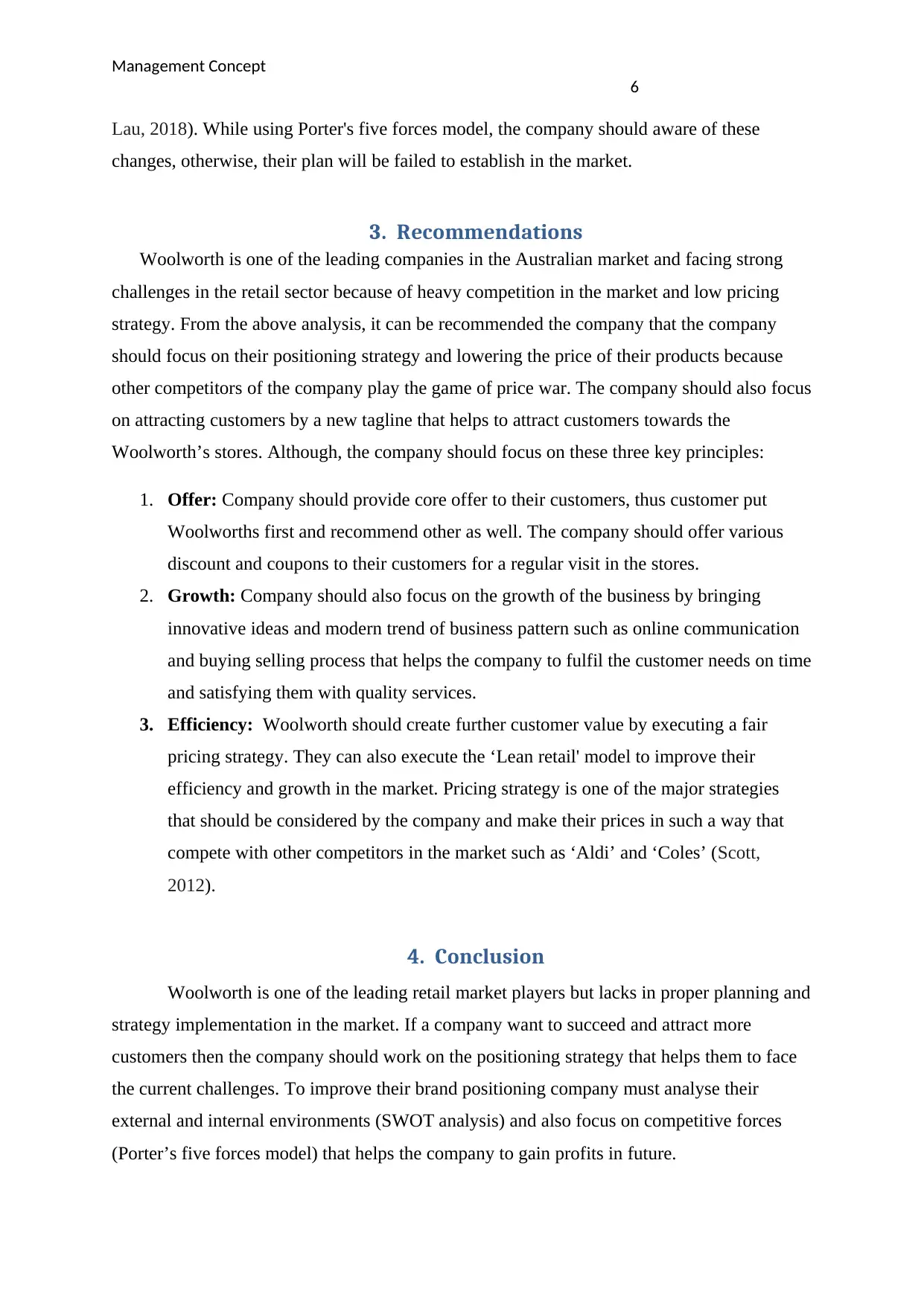
Management Concept
6
Lau, 2018). While using Porter's five forces model, the company should aware of these
changes, otherwise, their plan will be failed to establish in the market.
3. Recommendations
Woolworth is one of the leading companies in the Australian market and facing strong
challenges in the retail sector because of heavy competition in the market and low pricing
strategy. From the above analysis, it can be recommended the company that the company
should focus on their positioning strategy and lowering the price of their products because
other competitors of the company play the game of price war. The company should also focus
on attracting customers by a new tagline that helps to attract customers towards the
Woolworth’s stores. Although, the company should focus on these three key principles:
1. Offer: Company should provide core offer to their customers, thus customer put
Woolworths first and recommend other as well. The company should offer various
discount and coupons to their customers for a regular visit in the stores.
2. Growth: Company should also focus on the growth of the business by bringing
innovative ideas and modern trend of business pattern such as online communication
and buying selling process that helps the company to fulfil the customer needs on time
and satisfying them with quality services.
3. Efficiency: Woolworth should create further customer value by executing a fair
pricing strategy. They can also execute the ‘Lean retail' model to improve their
efficiency and growth in the market. Pricing strategy is one of the major strategies
that should be considered by the company and make their prices in such a way that
compete with other competitors in the market such as ‘Aldi’ and ‘Coles’ (Scott,
2012).
4. Conclusion
Woolworth is one of the leading retail market players but lacks in proper planning and
strategy implementation in the market. If a company want to succeed and attract more
customers then the company should work on the positioning strategy that helps them to face
the current challenges. To improve their brand positioning company must analyse their
external and internal environments (SWOT analysis) and also focus on competitive forces
(Porter’s five forces model) that helps the company to gain profits in future.
6
Lau, 2018). While using Porter's five forces model, the company should aware of these
changes, otherwise, their plan will be failed to establish in the market.
3. Recommendations
Woolworth is one of the leading companies in the Australian market and facing strong
challenges in the retail sector because of heavy competition in the market and low pricing
strategy. From the above analysis, it can be recommended the company that the company
should focus on their positioning strategy and lowering the price of their products because
other competitors of the company play the game of price war. The company should also focus
on attracting customers by a new tagline that helps to attract customers towards the
Woolworth’s stores. Although, the company should focus on these three key principles:
1. Offer: Company should provide core offer to their customers, thus customer put
Woolworths first and recommend other as well. The company should offer various
discount and coupons to their customers for a regular visit in the stores.
2. Growth: Company should also focus on the growth of the business by bringing
innovative ideas and modern trend of business pattern such as online communication
and buying selling process that helps the company to fulfil the customer needs on time
and satisfying them with quality services.
3. Efficiency: Woolworth should create further customer value by executing a fair
pricing strategy. They can also execute the ‘Lean retail' model to improve their
efficiency and growth in the market. Pricing strategy is one of the major strategies
that should be considered by the company and make their prices in such a way that
compete with other competitors in the market such as ‘Aldi’ and ‘Coles’ (Scott,
2012).
4. Conclusion
Woolworth is one of the leading retail market players but lacks in proper planning and
strategy implementation in the market. If a company want to succeed and attract more
customers then the company should work on the positioning strategy that helps them to face
the current challenges. To improve their brand positioning company must analyse their
external and internal environments (SWOT analysis) and also focus on competitive forces
(Porter’s five forces model) that helps the company to gain profits in future.
Paraphrase This Document
Need a fresh take? Get an instant paraphrase of this document with our AI Paraphraser
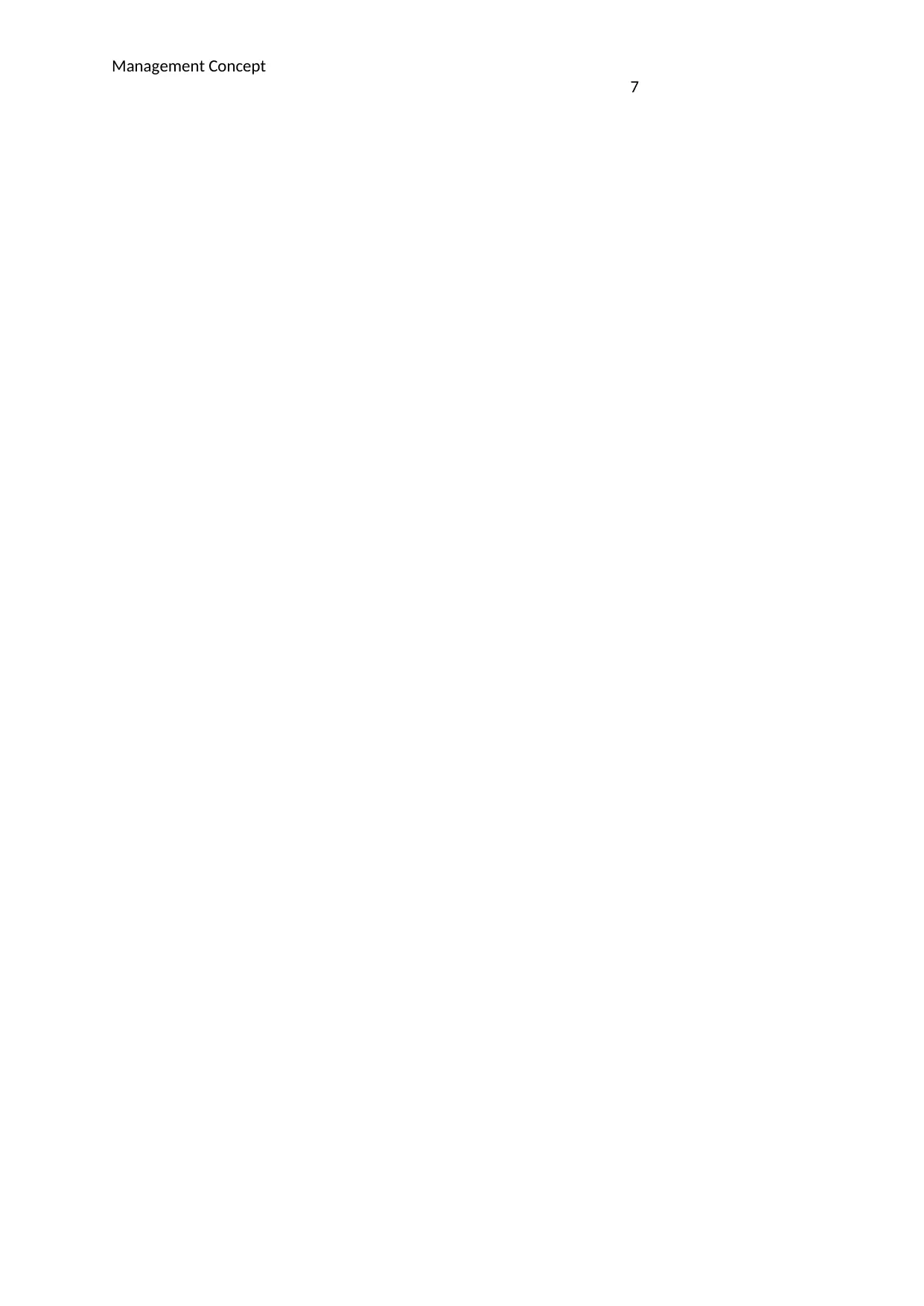
Management Concept
7
7
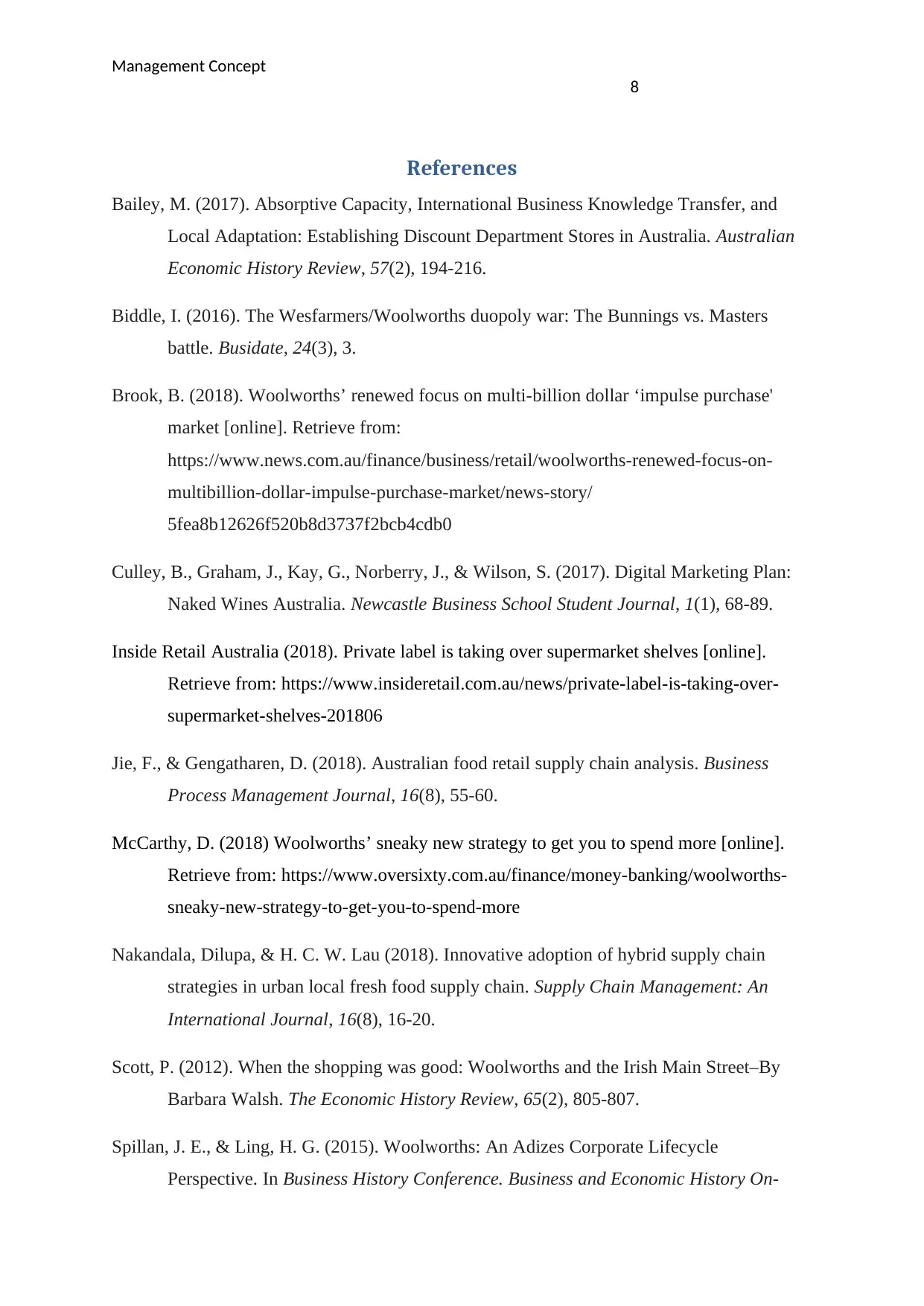
Management Concept
8
References
Bailey, M. (2017). Absorptive Capacity, International Business Knowledge Transfer, and
Local Adaptation: Establishing Discount Department Stores in Australia. Australian
Economic History Review, 57(2), 194-216.
Biddle, I. (2016). The Wesfarmers/Woolworths duopoly war: The Bunnings vs. Masters
battle. Busidate, 24(3), 3.
Brook, B. (2018). Woolworths’ renewed focus on multi-billion dollar ‘impulse purchase'
market [online]. Retrieve from:
https://www.news.com.au/finance/business/retail/woolworths-renewed-focus-on-
multibillion-dollar-impulse-purchase-market/news-story/
5fea8b12626f520b8d3737f2bcb4cdb0
Culley, B., Graham, J., Kay, G., Norberry, J., & Wilson, S. (2017). Digital Marketing Plan:
Naked Wines Australia. Newcastle Business School Student Journal, 1(1), 68-89.
Inside Retail Australia (2018). Private label is taking over supermarket shelves [online].
Retrieve from: https://www.insideretail.com.au/news/private-label-is-taking-over-
supermarket-shelves-201806
Jie, F., & Gengatharen, D. (2018). Australian food retail supply chain analysis. Business
Process Management Journal, 16(8), 55-60.
McCarthy, D. (2018) Woolworths’ sneaky new strategy to get you to spend more [online].
Retrieve from: https://www.oversixty.com.au/finance/money-banking/woolworths-
sneaky-new-strategy-to-get-you-to-spend-more
Nakandala, Dilupa, & H. C. W. Lau (2018). Innovative adoption of hybrid supply chain
strategies in urban local fresh food supply chain. Supply Chain Management: An
International Journal, 16(8), 16-20.
Scott, P. (2012). When the shopping was good: Woolworths and the Irish Main Street–By
Barbara Walsh. The Economic History Review, 65(2), 805-807.
Spillan, J. E., & Ling, H. G. (2015). Woolworths: An Adizes Corporate Lifecycle
Perspective. In Business History Conference. Business and Economic History On-
8
References
Bailey, M. (2017). Absorptive Capacity, International Business Knowledge Transfer, and
Local Adaptation: Establishing Discount Department Stores in Australia. Australian
Economic History Review, 57(2), 194-216.
Biddle, I. (2016). The Wesfarmers/Woolworths duopoly war: The Bunnings vs. Masters
battle. Busidate, 24(3), 3.
Brook, B. (2018). Woolworths’ renewed focus on multi-billion dollar ‘impulse purchase'
market [online]. Retrieve from:
https://www.news.com.au/finance/business/retail/woolworths-renewed-focus-on-
multibillion-dollar-impulse-purchase-market/news-story/
5fea8b12626f520b8d3737f2bcb4cdb0
Culley, B., Graham, J., Kay, G., Norberry, J., & Wilson, S. (2017). Digital Marketing Plan:
Naked Wines Australia. Newcastle Business School Student Journal, 1(1), 68-89.
Inside Retail Australia (2018). Private label is taking over supermarket shelves [online].
Retrieve from: https://www.insideretail.com.au/news/private-label-is-taking-over-
supermarket-shelves-201806
Jie, F., & Gengatharen, D. (2018). Australian food retail supply chain analysis. Business
Process Management Journal, 16(8), 55-60.
McCarthy, D. (2018) Woolworths’ sneaky new strategy to get you to spend more [online].
Retrieve from: https://www.oversixty.com.au/finance/money-banking/woolworths-
sneaky-new-strategy-to-get-you-to-spend-more
Nakandala, Dilupa, & H. C. W. Lau (2018). Innovative adoption of hybrid supply chain
strategies in urban local fresh food supply chain. Supply Chain Management: An
International Journal, 16(8), 16-20.
Scott, P. (2012). When the shopping was good: Woolworths and the Irish Main Street–By
Barbara Walsh. The Economic History Review, 65(2), 805-807.
Spillan, J. E., & Ling, H. G. (2015). Woolworths: An Adizes Corporate Lifecycle
Perspective. In Business History Conference. Business and Economic History On-
⊘ This is a preview!⊘
Do you want full access?
Subscribe today to unlock all pages.

Trusted by 1+ million students worldwide
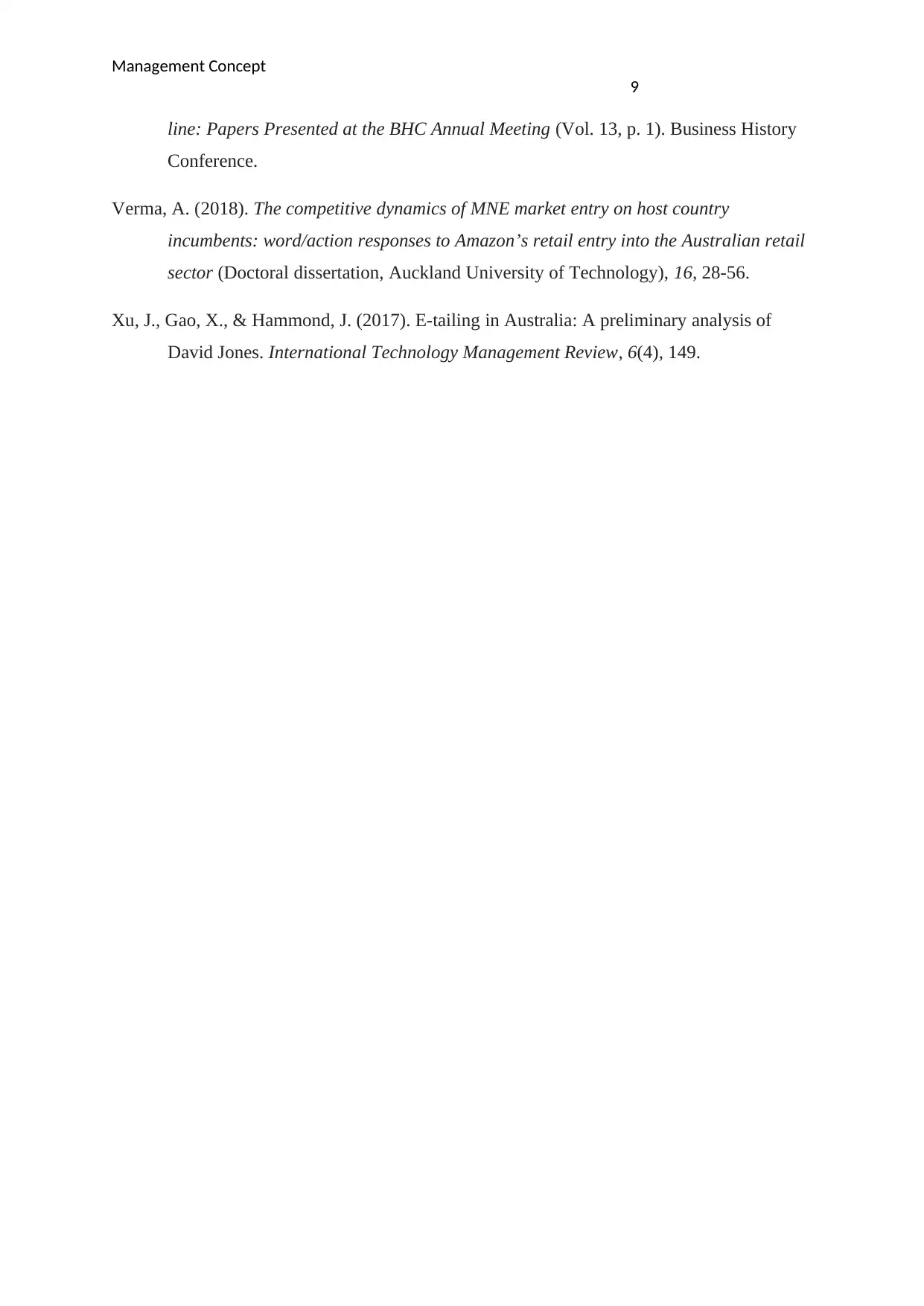
Management Concept
9
line: Papers Presented at the BHC Annual Meeting (Vol. 13, p. 1). Business History
Conference.
Verma, A. (2018). The competitive dynamics of MNE market entry on host country
incumbents: word/action responses to Amazon’s retail entry into the Australian retail
sector (Doctoral dissertation, Auckland University of Technology), 16, 28-56.
Xu, J., Gao, X., & Hammond, J. (2017). E-tailing in Australia: A preliminary analysis of
David Jones. International Technology Management Review, 6(4), 149.
9
line: Papers Presented at the BHC Annual Meeting (Vol. 13, p. 1). Business History
Conference.
Verma, A. (2018). The competitive dynamics of MNE market entry on host country
incumbents: word/action responses to Amazon’s retail entry into the Australian retail
sector (Doctoral dissertation, Auckland University of Technology), 16, 28-56.
Xu, J., Gao, X., & Hammond, J. (2017). E-tailing in Australia: A preliminary analysis of
David Jones. International Technology Management Review, 6(4), 149.
1 out of 10
Related Documents
Your All-in-One AI-Powered Toolkit for Academic Success.
+13062052269
info@desklib.com
Available 24*7 on WhatsApp / Email
![[object Object]](/_next/static/media/star-bottom.7253800d.svg)
Unlock your academic potential
Copyright © 2020–2025 A2Z Services. All Rights Reserved. Developed and managed by ZUCOL.




